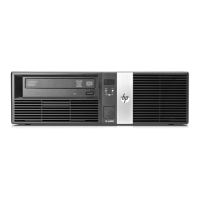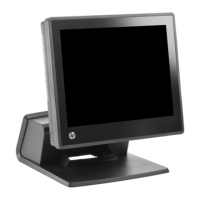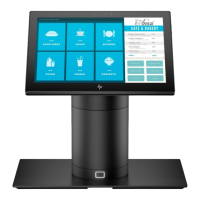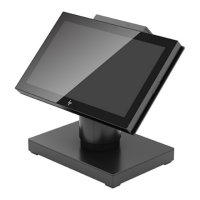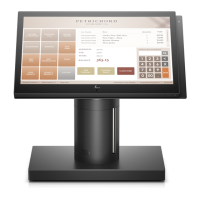Secondary Receiver Ready (SRRlSCF) line
must
also be
high. The
terminal
will
revert
back to
the
receive
state
if
the
condition
is
not
met
within
2.6 seconds.
There
is
no
timing
delay
when
switching
from
transmit
state
to
receive
state;
an
indefinite
wait
for Receiver Ready (RRlCF)
may, however, occur.
Line-turnarounds
in
half
duplex operation
are
governed by
the
following protocols:
1. Reverse Channel. This protocol requires
the
secondary
control lines RRlCF
and
SRRlSCF
and
is generally driv-
.
driven
by a
host
computer. A drop on
the
Secondary
Receiver Ready
(SRRlSCF) line will cause
the
terminal
to
enter
the
receive state. A drop on
the
Receiver Ready
(RRlCF)
line
will cause
the
terminal
to
attempt
to
enter
the
transmit
state.
2. Mainchannel (strict). This protocol uses
start
of
data
(SOD)
and
end
of
data
(EOD)
framing
characters.
The
SOD is optional
and
the
EOD is mandatory.
Any
data
received
after
an
EOD is discarded. This protocol, which
is common
in
Europe,
is
used
in
applications
where
a
drop on
the
Receiver Ready (RRlCF) line
results
in
an
extraneous
received character. Only
primary
control
lines
are
used.
a.
An
EOD
transmitted
by
the
terminal
causes
the
ter-
minal
to
enter
receive state.
b.
An
EOD received from
the
host computer causes
the
terminal
to
attempt
to
enter
transmit
state.
c.
An
EOD is
automatically
affixed to
the
end
of
each
block
transmitted
by
the
terminal.
d.
When
an
SOD
character
is
required,
any
data
received since
the
prior
EOD
and
prior to
an
SOD
is
discarded.
When
an
SOD
character
is required,
the
terminal
automatically
affixes one
to
the
beginning
of each block
transmitted
by
the
terminal.
e.
The SOD
and
EOD characters
may
be defined dif-
ferently for
transmit
and
receive state.
3.
Mainchannel (non-strict). This protocol
is
the
same
as
described above except
that
transitions
on control lines
may
also be used for causing transmit/receive
state
transitions.
a. An EOD
transmitted
by
the
terminal
or
a drop (high
to low) on
the
Secondary Receiver Ready (SRRlSCF)
line, whichever occurs first, will cause
the
terminal
to
enter
the
receive state.
b.
An EOD received from
the
host computer and/or a
drop on
the
Receiver Ready (RRlCF) line will cause
the
terminal
to
attempt
to
enter
transmit
state.
An
EOD
received
alone
will
cause
the
terminal
to
remain
in
receive
state
untill}RlCF drops,
at
which
time
the
terminal
then
attempts
to
enter
transmit
state.
Pacing Mechanisms
In
a full duplex
environment,
the
HP
2624A
can
par-
ticipate
in
either
ofthe
following forms of
transmit
pacing:
1.
Hardware
handshake.
A host computer
or
external
printer
can
temporarily
restrain
the
terminal
from
transmitting
by:
Data
Communications
a. Lowering
the
Clear
to Send (CB) line; or
b.
'furning
off Secondary Receiver Ready (SRRlSCF).
Normally a low
state
is
interpreted
as
"off",
but
you
can
use
the
InvertSRR field
in
the
terminal's
data
comm configuration
menu
to
invert
the
sense of
the
SRRlSCF line
so
that
a
high
state
is
interpreted
as
"off";
or
c.
Both
of
the
above simultaneously.
Note
that
this
type
of
transmit
pacing can only be used
in
a
hardwired
configuration.
2.
XON-XOFF
handshake. The host computer
or
external
printer
uses
the
ASCII control codes
XOH
«DC1»
and
XOFF
«DC3» to
start
and
stop
the
terminal
from
transmitting.
Note
that
a single
XOH
code cancels
any
number
of preceding
XOFF
codes.
In
a full duplex environment,
the
HP
2624A
can
also par-
ticipate
in
the
following forms ofreceive pacing:
1.
Terminal
Ready
handshake.
The
terminal
can
tem-
porarily
restrain
the
host computer from
transmitting
by
lowering
the
Data
Terminal Ready (TRlCD) line.
It
does
this
when
its
receive "working" buffer
is
full. When
enough
data
has
been processed
so
that
the
receive
buffer is only
half
full,
the
terminal
restarts
transmis-
sion from
the
host by
raising
the
TRlCD line.
Note
that
this
type of receive pacing
can
only be used
in
a hardwired configuration.
2.
XOH-XOFF
handshake. The
terminal
uses
the
ASCII
control codes
XON
«DC1»
andXOFF
«DC3»
to
start
and
stop
the
host computer from
transmitting.
Note
that
a
single
XON
code cancels
any
number
ofXOFF
codes.
In
either
a full or
half
duplex environment,
the
terminal
can
also
participate
in
an
ENG-ACK
handshake
which
is
a
Hewlett-Packard
handshaking
mechanism. With
this
form
of
handshaking,
the
host computer
transmits
a block of
data
and
the
then
sends
an
ASCII
<ENG)
control code. The
terminal
responds
to
the
<ENG)
by
sending
back
an
ASCII
<ACK)
control code
when
it
has
processed
all
of
the
data
preceding
the
<ENG).
The
general
interpretation
of
these
two control codes is
as
follows:
ENG:
"Have you processed
the
data
up
to
this
point?"
ACK:
"Yes,
I have."
The above pacing mechanisms
are
responded
to
by
the
terminal
in
the
following order of precedence:
1. Hardware
handshake
pacing (highest priority)
2.
XON-XOFF
transmit
pacing
3.
XON-XOFF
receive pacing
4.
ENG-ACK
pacing (lowest priority)
WARNING:
If
both
XOH-XOFF
transmit
pacing
and
XON-
XOFF
receive pacing
are
enabled,
it
is
the
responsibility of
the
host computer program
to
prevent
(or to detect and correct)
any
cases
of "deadlock"
that
may
arise.
If
the
terminal
sends
an
XOFF
and
then
receives
an
XOFF,
it
will not send
an
XON
until
first receiving one
from
the
host
computer.
7-15
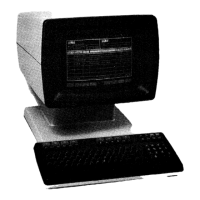
